what color palette to use with color pencils to verdigris patina
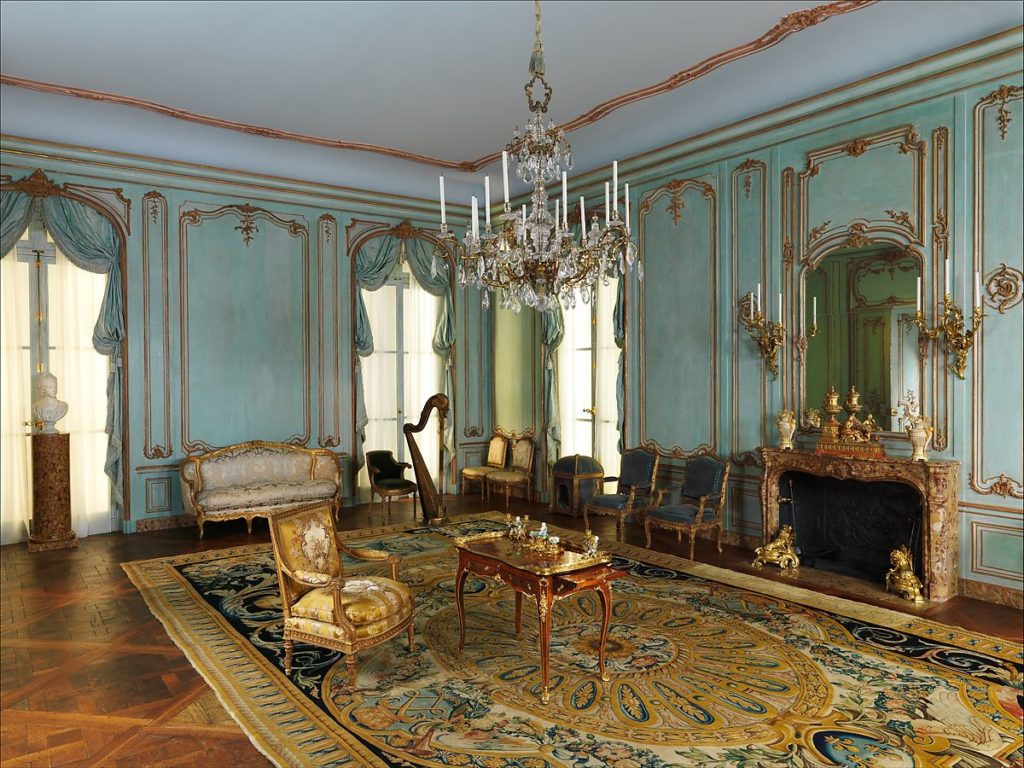
Palais Paar, Vienna, Republic of austria, ca. 1765–72 (Courtesy Metropolitan Museum of Art)
It's difficult to imagine now, but people in one case gathered together freely, shoulders rubbing confronting shoulders, jiff exchanged between lungs, bodies open to one another—all this closeness, virtually a million people standing in a crowd merely to watch a statue get undressed.
It was a rainy October twenty-four hour period in 1886 and the Statue of Freedom was shrouded in a French flag. The weather was miserable and the ceremonial unveiling went poorly. The drapery was pulled off too soon (correct in the middle of a speech), and the fireworks display had to be canceled and rescheduled. Still, over a million freezing New Yorkers came out (including a boat full of suffragettes, protesting the statue). While it'southward difficult for me to even imagine standing inside a crowd of that size, it's harder still to imagine the Statue of Liberty herself, every bit she looked then. Before she was the verdigris icon, patron saint of many a bespoke paint colour, she was copper-skinned. Brown, non green.
It felt like a revelation to read that tiny detail in Ian Frazier's New Yorker slice on Statue of Liberty green. When residents start beheld Lady Liberty, they saw not an otherworldly, aqua-skinned apologue holding her lit torch to the sky, just a metallic, imperial woman stretching upward from a granite plinth. Information technology'southward a simple enough fact, and yet I have trouble wrapping my caput effectually it. Brownish, non green.
She was chocolate-brown because that's the colour of copper, an interesting chemical metal that occurs in a usable class frequently in nature. She is green because that'south the colour of verdigris, a substance that both is and isn't turquoise. She's green because nosotros live surrounded past oxygen and when oxygen comes into contact with a metal like copper, it begins to tear abroad the electrons, which allows for the copper atoms to begin reacting with other particles. On the declension, uncoated metallic can come up face-to-face with harsh seawater, a substance that is naturally full of salt—ions and carbonic acid. Thus, the Lady's metal pare gains a thin, colorful coating fabricated of copper chloride. This crystalline solid appears to the man centre as a low-cal robin's-egg blue, a turquoise patina, a soft hue somewhere between green and blueish.
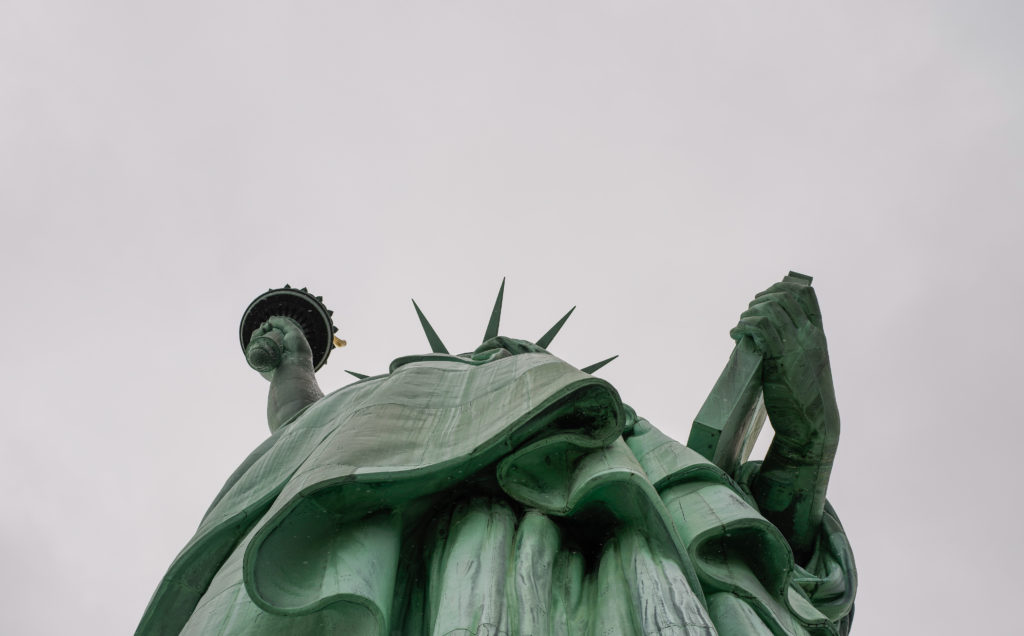
Statue of Liberty, Annie Spratt, Wikimedia Commons
Next to the shifting and dated definition of millennial pinkish, the green-blue spectrum is perhaps my favorite color quandary. It's a surprisingly loaded issue: where one ends and the other begins, and what to call the colors in between. For centuries, there was a myth circulating in white civilisation that the more than words we had for colors, the more than colors we could come across. Since some cultures don't have separate words for green and blue, some historians believed that the people who spoke those languages couldn't see the deviation, that their visual skills were bottom-than, that their abilities were less evolved than the cultures that named these leaves green, that puddle bluish. Co-ordinate to this logic, English language speakers were superior considering of our words for green and blue—not to mention our words for all those shades that exist in the gradient betwixt them.
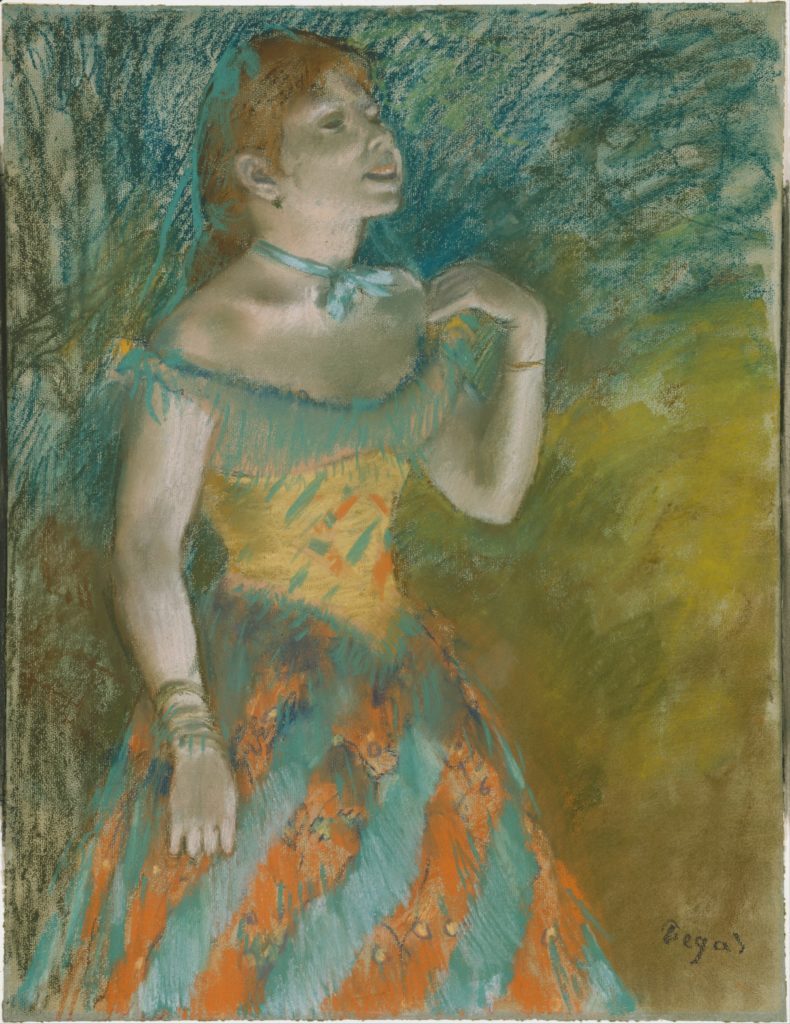
Edgar Degas, The Vocaliser in Dark-green, 1884
This is well-nigh likely not the case. People'due south eyes work mostly the aforementioned around the globe (save for notable exceptions, such equally those who are visually impaired or color blind). The fact that we're living in an increasingly colour-literate world doesn't mean we're irresolute how nosotros see. But we are changing how nosotros wait.
Since I became interested in colors a few years agone, I began amassing a mental collection of in-betweens. Colors that didn't fall into a clear category. Colors that I felt were misnamed or misunderstood. The majority of them cruel into the aforementioned saucepan as so-called copper green. In here, I threw aqua, cyan, turquoise, teal, and Tiffany. I filed abroad glaucous and Cambridge Blue. None of them are actually blue and none of them are really green. I suppose they're all shades of turquoise, yet that seems wrong, besides. Turquoise is a relatively new proper name. Before there was turquoise, at that place was verdigris.
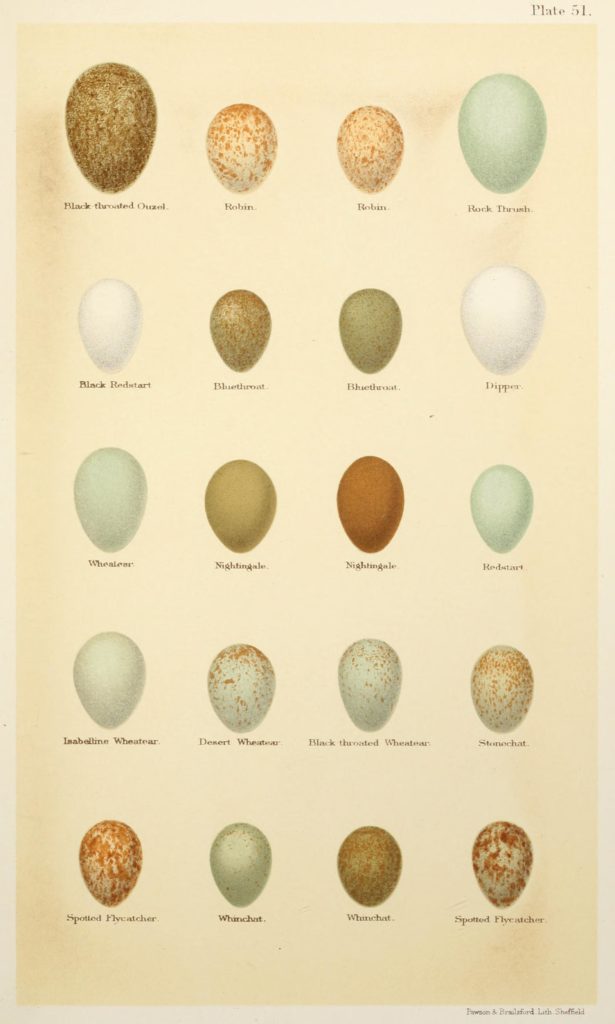
Eggs of British birds, Seebohm, 1986
Verdigris is the ur-turquoise. The name comes an Former French term, vert-de-Grèce ("greenish of Greece"). It is also sometimes known as "copper green" or "earth green," since the pigment was commonly made from ground-upwardly malachite or oxidized copper deposits. Certainly, verdigris owes a great debt to copper (symbol: Cu), every bit exercise the gemstones turquoise (chemical composition: CuAlhalf dozen(PO4)four(OH)8·4H2O) and malachite (chemical limerick: Cu2COthree(OH)2). In America, nosotros're more than likely to phone call these green-blue shades turquoise (from the One-time French for Turkish, or "from-Turkey") or Tiffany Blue (coined in 1845 with the publication of the Tiffany'south Bluish Book catalogue and trademarked in 1998) than we are to invoke old-timey verdigris. Withal I prefer the odd one-time name, with its vivid consonants and slithery tail. The word sounds unstable, fittingly fluid for such a liquid hue.
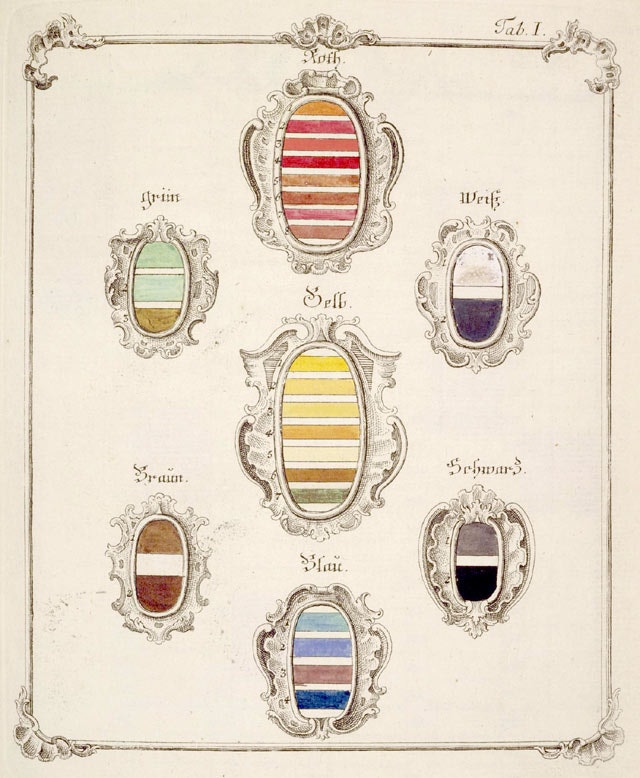
Prototype from Jacob Christian Schäffer's Entwurf einer allgemeinen Farbenverein, 1769
For many hundreds of years, verdigris was the almost brilliant green readily available to painters. In the Middle Ages and during the Renaissance, artists commonly manufactured verdigris by hanging copper plates over boiling vinegar and collecting the crust that formed on the metal. This was mixed with binding agents, similar egg white or linseed oil, and applied to canvas, paper, or wood. While non all of these famous works have been chemically analyzed, verdigris can reportedly be seen in paintings past the likes of Botticelli, Bosch, Bellini, and El Greco. But like Lady Liberty, who started as brown and lightened to green, many of these works have morphed over the years, their brilliant hues fading from saturated cyan or emerald (depending on how the colour was mixed) to murky grays and pond-water browns. For verdigris is both toxic and unstable, a fact that Leonardo da Vinci knew, though he persisted in using it still. ("Verdigris with aloes, or gall or turmeric makes a fine green and then it does with saffron or burnt orpiment; but I incertitude whether in a short time they will not turn black," he wrote.) It was simply such a beautiful color, and then accessible. It was hard for painters to resist, even when they knew it would render their works mortal. To use verdigris was to accept that your lovingly rendered scene would one day sour. The vivid cloaks would plough dark, the soft grass would fade, the foliage turn. Merely such is the nature of cloth and plants and paint. Such is the nature of beauty.
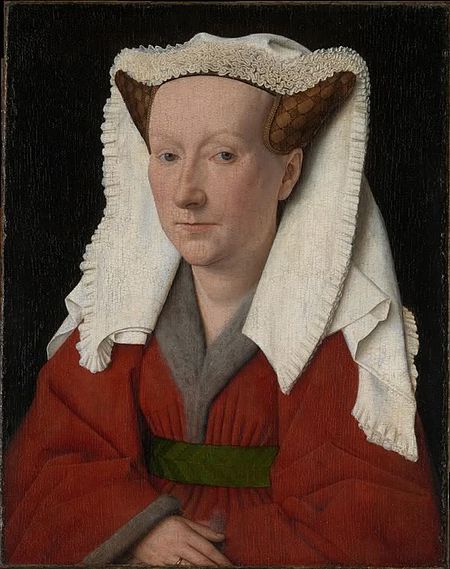
Jan van Eyck, Portrait of Margaret van Eyck, 1439
Of course, it is possible to restore a painting. Sometimes, when a painting is restored, the conservationists utilise synthetic pigment to retouch areas where the color has faded or changed. This was the instance with Jan van Eyck's Margaret, the Artist's Wife, which hangs in the National Gallery in London. "Following cleaning the small losses and areas of damage needed to be retouched then that they exercise not distract from the compelling image and from Van Eyck'south immaculate painting technique," writes Jill Dunkerton in her report on the process. "The materials used for the new restoration have to be stable, non changing colour like the old varnish and retouchings, and they must remain hands resoluble so that the painting can be safely cleaned again in the future. Carefully selected and tested modernistic synthetic resin paints are therefore employed." While in some cases, the restored painting can wait alarmingly different from the 1 we're used to seeing (like with that ghastly Ghent lamb), Margaret doesn't. She looks nice after her spa treatment—refreshed and pink. Her green accessories don't look overly brilliant either, nor has her headdress been ruined. The National Gallery's painstaking work paid off, and were Van Eyck around to run across it, he might exist quite pleased.
Yet at that place is something uncanny most even the nigh well-done restoration, merely as there'south something strange about seeing pictures of the Statue of Liberty with her original copper coloring. Lately, I've found myself becoming increasingly skeptical about the value of authenticity as a goal. According to the logic of our time, it is important to exist "real". What is real? Existent is authentic, unadorned, unchanged. Often, the "existent" meaning is the primary one. What something "really" ways is what it meant, according to traditionalists. This argument has large implications when information technology'due south applied to things like the Bible or the Constitution. When applied to art, the stakes are much lower. But the logic still feels strange. It discourages appreciation for alter, for the slow evolution of things. Lady Freedom isn't "really" brown. She's both brown and greenish and grayness and a multitude of other colors. Greek temples aren't "really" colorful; they were once colorful and at present that'southward gone and peradventure someday they'll exist colorful once again, if that'southward the will of the people.
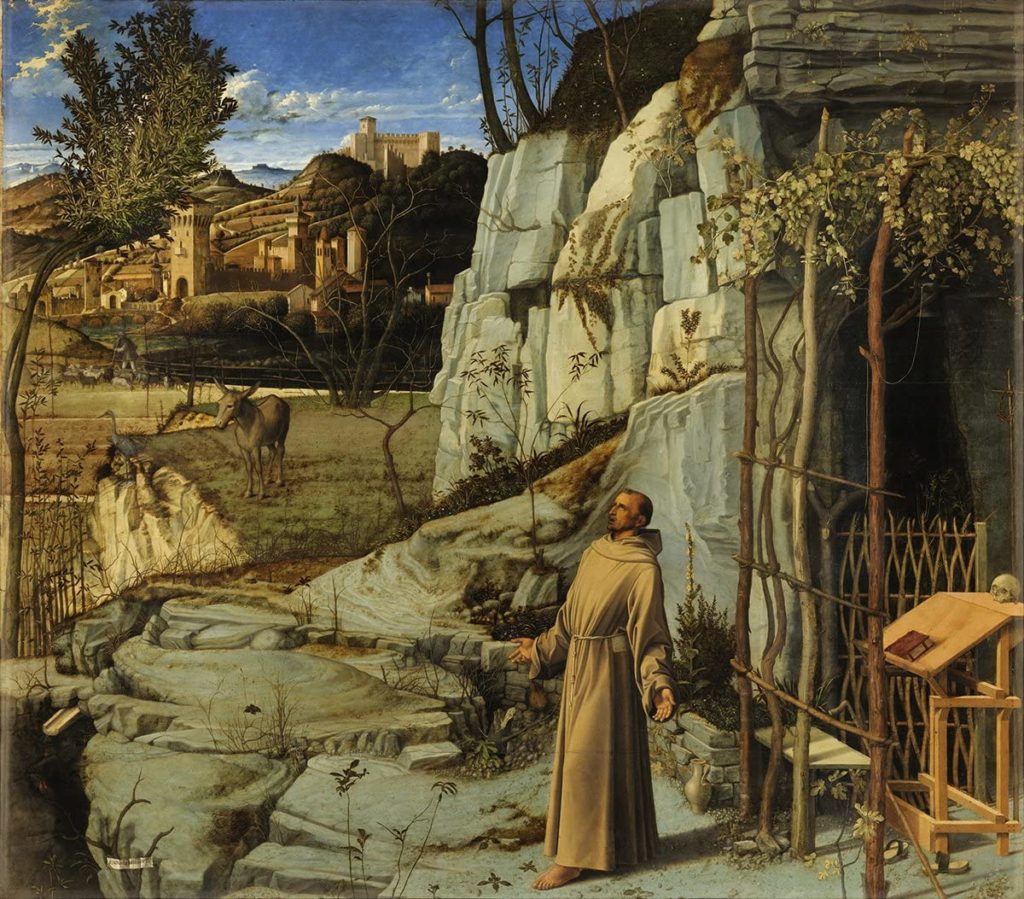
Giovanni Bellini, St. Francis in Ecstasy, 1480
I'm guilty of insisting on primacy myself, I know. At times, I've argued for the existent definition of a color. Just I also like how colors change, how words modify, how material things age. Wood expands and contracts, copper gets weathered by the sea, and words move through cultures. What nosotros call mauve isn't what Victorians considered mauve. Aforementioned with puce. Same with so many other hues. Verdigris is emblematic of that movement. It'south a blue-green, yes. Merely more importantly, it's a quality. Information technology is hard to give information technology a hex code because it's non flat. It's a color made from change.
My contempo interest in verdigris was piqued by the newfound ubiquity of Farrow & Ball colors, including the saturated teal they're calling Verdigris. You lot might detect that I wrote colors in that location and not paints. Farrow & Brawl is a high-stop paint make that has been profiled in the New Yorker and spoofed on SNL. Information technology's a subtle condition marker that indicates a level of refinement in ane's private sphere. The paint itself isn't really everywhere; I've seen it used in some house projects, but information technology's non every bit mutual every bit you might recollect. Being able to name-check a Farrow & Brawl hue indicates that you're in possession of a certain level of cultural majuscule. It'due south also a funny kind of upper-case letter, because y'all don't have to spend coin on Farrow & Ball to proceeds access to this rarefied sphere. A few interior designers accept confessed to me that they utilize Benjamin Moore dupes for Farrow & Ball hues in their personal homes, since it'southward nigh impossible to tell the difference. The paint isn't the point—information technology'south the name that matters.
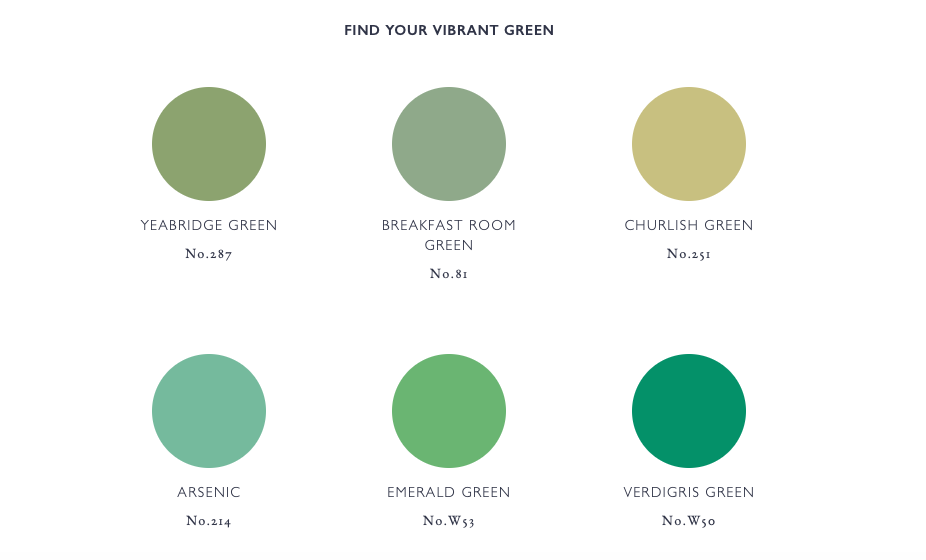
Farrow & Brawl paint colors
And Farrow & Ball names are very, very good. Some are whimsical and child-similar (like Mole'due south Breath or Mouse'south Back), some are charmingly former-fashioned (Lamp Room Gray or Wavet, an "old Dorset term for a spider's web"); a few are winter vegetables (Cabbage White, Brassica, Broccoli Brown), a few are plain fancy (Manor Firm Gray, Mahogany), and many are but obscure (Incarnadine, Dutch Orange, and Verdigris). Reading through the listing reminds me of when I was a kid, browsing J. Crew catalogues for overpriced sweaters, wondering what kind of woman would wear a "harvest grape" cashmere vanquish or a "dusty cobblestone" merino turtleneck. Information technology has the same preppy, one-time coin allure. A person who would paint their sleeping room Brinjal ("a sophisticated aubergine") probably spent their babyhood in a house with a drawing room, summering in some coastal region I've never heard of, and capering about in kid-size loafers. They're a competent sailor. They have never applied for Obamacare.
Enough of paint companies take hues named for the color of salt-water-aged metal, including Donald Kaufman's "Freedom Green," Benjamin Moore'southward "Lady Liberty," Sherwin-Williams's "Parisian Patina," and Behr'southward "Copper Patina." And while in one case I might have argued that one pigment color is correct, I don't want to practise that. Farrow & Ball'due south Verdigris is no less existent than Behr's. It'due south as well no more true.
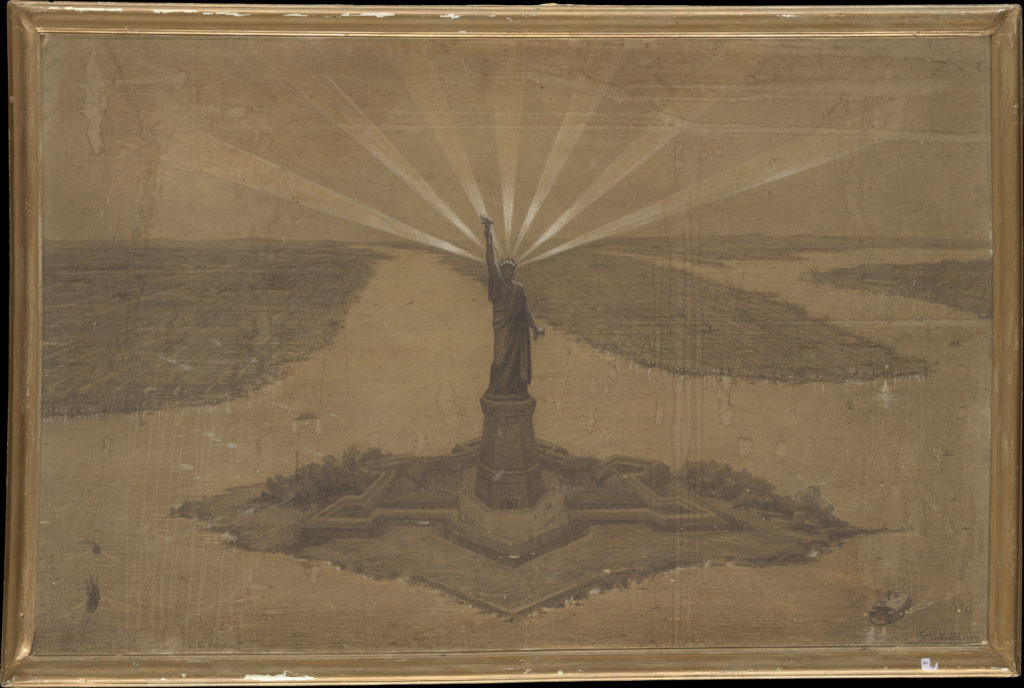
Frédéric-Auguste Bartholdi, Presentation Drawing of "The Statue of Liberty Illuminating the World," 1875
I like verdigris, and all these dark-green, eggy blues, considering it reminds me that Tiffany doesn't own turquoise. Neither do the mine owners in Colorado who are trying to brand their turquoise, nor does the silver company that bought upwardly all the stones from a single town. You can own a stone and you can patent a color, only you can't own the word or the significant. The minute you try, you lose something.
Over a hundred years agone, the United States Army began looking into turning the Statue of Liberty back to her original copper color. "As might be expected, when the Statue of Freedom turned green people in positions of authority wondered what to do," writes Frazier. "In 1906, New York newspapers printed stories saying that the Statue was before long to be painted. The public did non like the idea." In the stop, nothing was done. Change was accepted, and we let her green skin stay. And like a word moving through years, shifting its meaning, she continues to change, ever so slightly. As an architect told Frazier, verdigris is not opaque. It is "crystalline … you're looking into it." You're seeing a century of change and molecular growth. You're seeing into the past. There'due south brown. In that location'south dark-green.
Source: https://www.theparisreview.org/blog/2020/11/24/verdigris-the-color-of-oxidation-statues-and-impermanence/
0 Response to "what color palette to use with color pencils to verdigris patina"
Post a Comment